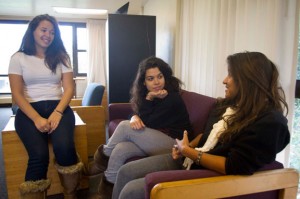Ithaca College’s freshman class has shown a slight increase in the total percentage of African, Latino, Asian and Native American students.
The 0.5 percent increase from last year is the result of a smaller freshman class, Eric Maguire, vice president of enrollment and
communication, said.

In 2009, 297 ALANA students enrolled for the class of 2013, making up 14.7 percent of the class of 2,027 students. This year’s freshman class has 245 ALANA students, which is 15.2 percent of the total class of 1,617 students, according to the
Office of Institutional Research.
ALANA students make up 13.8 percent of full-time students at the college this year, compared to 12.2 percent last year. Numbers for each ethnicity, however, have fluctuated.
Between this year and last, Hispanics in the freshman class represented the only increase. Latinos increased by 1.4 percent, African-Americans went down by 0.8 percent, American Indians decreased by 0.7 percent and Asians decreased by 2 percent.
Maguire said changes within racial categories are the nature of yearly fluctuations.
While these percentages show a steady decline, when compared with enrollment from 2006 to 2008, the percentages are similar.
The college is waiting for results from the Diversity Strategic Planning Committee, which is drafting a five-year plan to increase diversity among students and faculty, Maguire said.
The report will come out in the next few months, Maguire said.
“The general trend is an upward one, and it is my hope that we are able to continue on that upward path to continue ALANA diversity,” he said.
John Rawlins, assistant director of the Office of Student Engagement and Multicultural Affairs, said the college should enhance its efforts to increase the number of ALANA students through initiatives like the MLK Scholarship Program, a scholarship opportunity for students of minority backgrounds who demonstrate financial need and merit.
“I’d love to see the MLK program fully funded,” he said. “The program is amazing right now, but when you’re talking about some students who have a lot of need, it may just not be enough.”
In response to concerns like this, the college announced earlier this semester that the baseline for the class of 2015 MLK scholarships would be increased from $18,000 to $25,000. MLK scholarships can pay up to the cost of full tuition.
Rawlins said the increase in the scholarship will appeal to students because it will increase their chances of being able to pay for the college.
“Right now there are individuals who the college interviews for the scholarship, but then they get offers from other institutions that are better, and even though they love the program, they can’t necessarily come here because of money,” Rawlins said.
After taking note of student responses to the recruitment mediums such as FUSE magazine, the college reallocated some of its funds from publication recruitment to more personal forms. The college now has a representative in Boston and one in New York City whose main job is to recruit students of all backgrounds.
To some students, increasing diversity enhances the learning environment at the college.
When sophomore Shyanne Ruiz was deciding where she wanted to go to school, she never thought she would end up in Ithaca.
A native of Philadelphia, Ruiz said she was constantly surrounded by a large diverse pool of people, including blacks, whites and Latinos, like herself.
After spending time on campus, Ruiz has integrated herself into the college, keeping her culture alive through her involvement in the IC Muevete Dance Company and the African-Latino Society. Ruiz is now focusing on what needs to be done to improve the ALANA community and the way Latinos are perceived on campus. Ruiz said she noticed discrepancies in the way the college presents diversity to prospective students.
“Some people may feel that they are being betrayed about how much diversity there is,” Ruiz said. “All the programs for Inside Look consist of mainly ALANA students, which really makes it seem like there is a lot more diversity than there really is.”
Maguire said the college sponsors these events as a means to offer students a mixed cultural experience.
“The purpose of [these programs] are to address diversity in a very targeted way,” Maguire said. “It attracts a lot of ALANA students to the institution, while we aren’t trying to misrepresent those numbers.”







